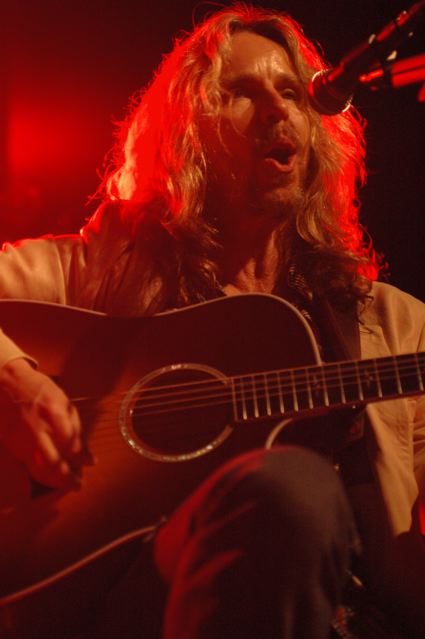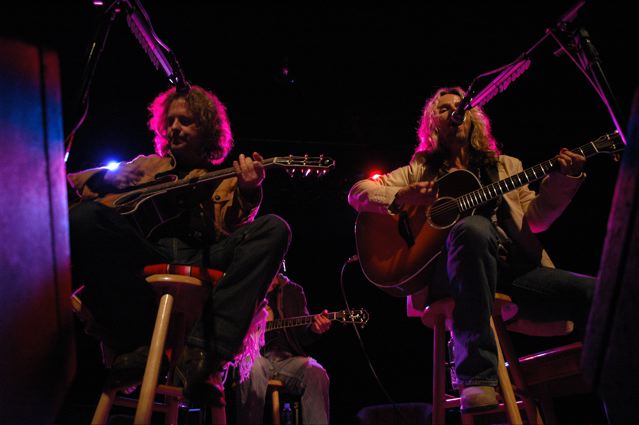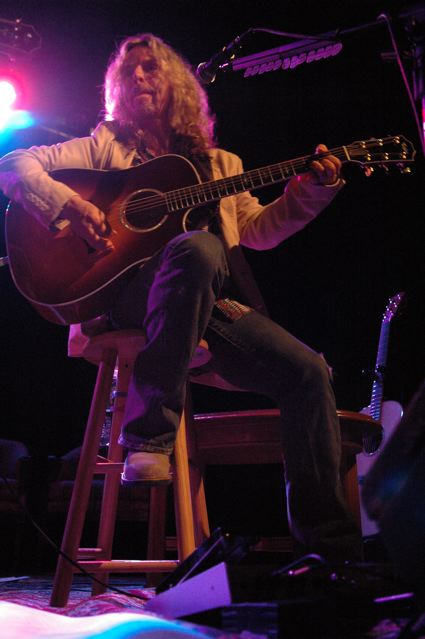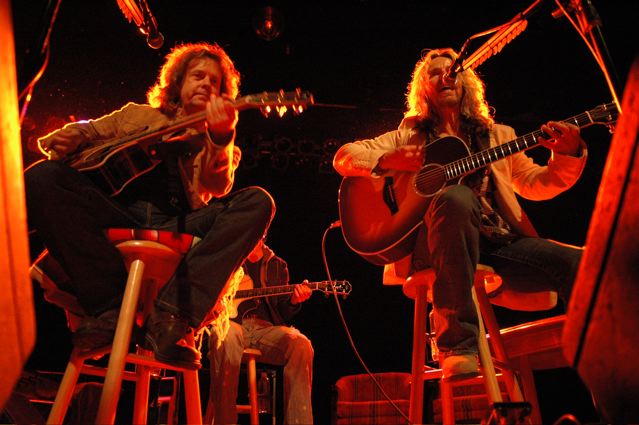Copyright ©2007 PopEntertainment.com. All rights reserved.
Posted:
April 11, 2007.
Tommy
Shaw was the lead guitarist and rock-and-roll voice of
STYX – one of the most popular rock bands of the 70s and 80s.
Joining the band right before it exploded, Shaw contributed the songwriting
and vocal chops to some of the band’s classic tunes such as “Too Much Time
on My Hands,” “Fooling Yourself (The Angry Young Man),” “Crystal Ball,”
“(Blue Collar Man) Long Nights” and “Renegade.” STYX broke up in 1984 after
the turmoil of the recording of the concept album
Kilroy
Was Here
and the complicated ensuing tour.
Shaw
spent the rest of the 80s working on an up-and-down solo career which never
reached the heights of his band work. His biggest (and first) solo single
was the 1984 rocker “Girls with Guns,” which barely dented the top 40.
In the
early 90s, Shaw blasted back to the top of the charts with singles like
“High Enough” and “Where You Going Now?” from his supergroup Damn Yankees.
That group featured the three-pronged guitar attack of Shaw, Jack Blades –
singer/songwriter of popular 80s rock band Night Ranger (“Sister Christian,”
“[You Can Still] Rock In America” and “Sentimental Street” were some of
their biggest) and Motor City Madman Ted Nugent (“Cat Scratch Fever” and
“Wango Tango.”)
Nugent
left the group after the second Damn Yankees disk, so Shaw and Blades
released a CD called
Hallucination
in 1995 together. When that did not quite take off, Shaw returned to the
reformed STYX. However, Shaw never forgot his partnership with Blades and a
decade after the debut (and long-presumed final) Shaw Blades disk, they got
together to re-release
Hallucination.
They
enjoyed the experience of being back together so much that in 2007, they
have released
Influence
– which is just what the title suggests, a new group of
fun remakes of songs
which turned the two on to music. Not just a fun side project,
Influence
has
returned Shaw Blades to the rock charts with a surprising cover of the YES
classic “Your Move.” Other favorites on the album include the Mamas & the
Papas’ “California Dreaming,” Simon & Garfunkel’s “Sounds of Silence” and “I
Am a Rock,” Emerson Lake and Palmer’s “Lucky Man” and Steely Dan’s “Dirty
Work.”
Shaw
was nice enough to check in with us from the road while doing a fun
small-club tour with Blades – where the duo play well over two hours worth
of acoustic versions of their favorite songs from growing up, as well as
signature tunes from STYX, Night Ranger and Damn Yankees.
 How did you originally get into music?
How did you originally get into music?
I always loved the
variety shows on television when I was a child. I
got a guitar on my tenth birthday which sealed my fate.
STYX
had been recording a little while before you joined the band. How did you
get together with them?
Their tour manager at
the time, a fellow named Jim Vose, came to a gig of mine in Chicago when I
was in MS Funk and introduced himself to me. When the day came that they
needed someone to replace John Curulewski, I was called. They flew me up
from Alabama and I auditioned, sang the high note on "Lady" and was hired.
One of my first dates was to see
STYX at the Philadelphia Spectrum on the
Paradise Theater
tour. You were huge. For a period of several years, you were part of arguably the biggest
rock band in the US. How surreal was that whole experience?
You hit it on the
head. It was surreal. We’d been working as hard as we could to get
positioned on larger and larger shows with the top bands. When the success
came it seemed overnight. I was young, somewhat single, ready to take it
all in, and I did.
STYX sort of
imploded in 1984 after all the turmoil of the
Kilroy Was Here
album and tour. When did you know the band had sort of run its course?
We probably knew a
while before it fell apart but we had gotten comfortable with our
dysfunctional way of dealing with each other by complaining to our manager
who would try to smooth things over. In hindsight if we’d been better able
to communicate with each other it’s possible we might not have had such an
acrimonious split. But then again, the personalities were what they were
and chances are we’d have had to go our own way anyhow. One can only
speculate.
You released three solo CDs in the period
between the original breakup of STYX and Damn Yankees. I have to say I really liked some of your solo
singles like “Girls with Guns” and “Ever Since the World Began.” Was it
disappointing that your solo stuff never caught on like the stuff you did in
STYX?
My solo career needed
a lot more developing than I gave it. I was used to being in the studio
with the band and overestimated my own ability to make the album I wanted to
and had to rely on others. Very talented people but it’s different when you
are in the studio following your own vision. At the time mine was probably
a bit blurred. I have no regrets because it all led me to where I am today.
In
the late 80s, you got together with Jack and Ted Nugent to form Damn Yankees
and had a few big hits – particularly the first CD did really well. When Ted
left Damn Yankees, you and Jack did one Shaw/Blades album in the 90s. You’ve
been back recording and touring with Styx regularly, and yet a decade later
you have just re-released the first Shaw/Blades CD and now recorded a second in the last couple of years. What is it about this side project that you
like which you can’t get with the day job?
 Jack Blades and I
have the most uncanny chemistry I’ve ever had with another writer and
singer. It’s always been and remains so easy and malleable that there’s
never a struggle. Because we are not as big as STYX we have fewer
expectations and can be more flexible in how we approach everything—for
example we are currently on an all acoustic tour with a third musician, Will
Evankovich (lead singer for American Drag) and are performing an
ever-changing songlist of music from every single incarnation between us,
which at last count was six. We go off the page, jamming, exploring the
spontaneous callings of many of these songs to what seems to be the sheer
delight of fans who are following us. We could not do that with STYX ,
Night Ranger or Damn Yankees.
Jack Blades and I
have the most uncanny chemistry I’ve ever had with another writer and
singer. It’s always been and remains so easy and malleable that there’s
never a struggle. Because we are not as big as STYX we have fewer
expectations and can be more flexible in how we approach everything—for
example we are currently on an all acoustic tour with a third musician, Will
Evankovich (lead singer for American Drag) and are performing an
ever-changing songlist of music from every single incarnation between us,
which at last count was six. We go off the page, jamming, exploring the
spontaneous callings of many of these songs to what seems to be the sheer
delight of fans who are following us. We could not do that with STYX ,
Night Ranger or Damn Yankees.
I believe the new CD is one of the first
releases on VH1 Classic Records. How did that come about?
Jack and I and
finished the CD, financing it ourselves. We owed nobody, owned it
outright. After getting lukewarm receptions from major labels, Jack gave a
copy to Eric Sherman at VH1 Classic, who was about to launch their own
label. It was typical of how this project seems to have had a charmed life
at every step.
How is working with a smaller label like
this or CMC or New Door different than a major during the glory days of STYX
and Damn Yankees?
There was a time when
labels routinely paid half a million dollars for an album to be recorded.
There was a culture of spending that was like a small scale version of
making a major motion picture. Now, with home studio equipment removing the
financial gatekeeper in the recording phase, albums are made more like
independent films, to keep with that example. To survive, labels will now
go into partnership deals with artists. So much music is burned and
recopied now, it’s impossible to know how many people own your music, but
fortunately for us, I believe a big part of our audience would still rather
have their own copy with liner notes rather than having to burn it and have
a blank with magic marker titles.
 Now you’ve done covers albums with both
STYX
and Shaw/Blades. As a respected songwriter, is it at all weird doing an
album that’s entirely other people’s work?
Now you’ve done covers albums with both
STYX
and Shaw/Blades. As a respected songwriter, is it at all weird doing an
album that’s entirely other people’s work?
There is so much good
music out there. It’s a real treat to do an album like
Influence.
It was a little harder to do a STYX record like
Big Bang Theory,
because we are such a dyed in the wool original music band, but we still had
a great time making it.
There was a really interesting collection
of songs on the album. While you did music from some of the greatest rock
bands, you also picked some songs that might not be obvious choices for
people with a rock background like you and Jack; things like “Summer
Breeze,” “Dance With Me,” “California Dreaming” and “I Am A Rock.” Were you
trying to show your musical diversity of tastes with the song choices?
We literally meant
what the title says. These songs did influence us when we were younger.
They made us who we are today. Think of the harmonies in our respective
bands as well as Damn Yankees. The Hollies, ELP, YES, Simon and Garfunkel,
etc., all had a major impact on how we looked at the world of musical
possibilities.
There are two Simon & Garfunkel songs on
the album. How hard was it to choose from all the great tunes in Paul
Simon’s songbook?
I did a demo of “I Am a Rock" right away when we discussed
the possibility of making this album. It was a natural and was on the list
from the get go. "Sound of Silence" was another one we’d both played and
sang as youngsters.
The recordings here are pretty faithful to
the original songs – some songs like “Time of the Season” and “I Am a Rock”
were made a bit more rock-oriented, but the original tunes were pretty clear
in the recordings. Did you decide early on not to play too much with the
original structure of the songs like some people do when making covers?
We let the songs tell
us what to do. As soon as I dropped the E down to a low D on my 12 string
acoustic, it began to grow on its own.
How do you think bands like Simon and
Garfunkel, Yes, The Zombies and others you have covered here have influenced
today’s bands?
Anyone who was around
when these songs first came on the radio, or who has since taken the time to
get to know them, would be hard pressed to not be influenced by them.
Unless perhaps they were not aware of the fact that these were the pioneers,
that they have been the influence behind so many others who have come along
since.
 One thing that is great about the bands you covered is that they weren’t
afraid to have a tune. A few years ago it was something of a sell-out for a
rock band to have a melody. Why do you think the world is so ready for more
melodic rock?
One thing that is great about the bands you covered is that they weren’t
afraid to have a tune. A few years ago it was something of a sell-out for a
rock band to have a melody. Why do you think the world is so ready for more
melodic rock?
We go through cycles. Sometimes what’s needed is a good
old-fashioned primal scream. Try it sometime. It cleans out the spiritual
cobwebs. But eventually that scream softens into an articulated message,
and when it comes from our souls it often has a melody. Melodies imprint on
our psyche more than screams. For us, we’ve had the good fortune to do a
little of both when we were in Damn Yankees, but now we’re really enjoying
singing these melodies.
Several of the artists who you recorded on the album – like Jon Anderson of
YES and Michelle Phillips of the Mamas and the Papas – have come out and
said that they really liked your recordings of their songs. How gratifying
is that?
You have no idea what this means to us. When I see the
wonderful comments we’ve received from Michelle Phillips, Greg Lake, Graham
Nash, Jon Anderson and others whose songs we covered on Influence, I
am shot back in time to when I first heard these songs. If someone had told
me back then that years later I’d be getting a thumbs up from the
originators for our performances of these songs I would have been hard
pressed to imagine it really happening.
In the end, how would you like people to look over your
career and your music?
I hope my music put a smile on a few faces and distracted
them from their daily routines from time to time.
Are there any misconceptions you'd like to clear up?
I’m a lot taller at family reunions.
Email
us Let us know what you
think.
Features
Return to the features page.
